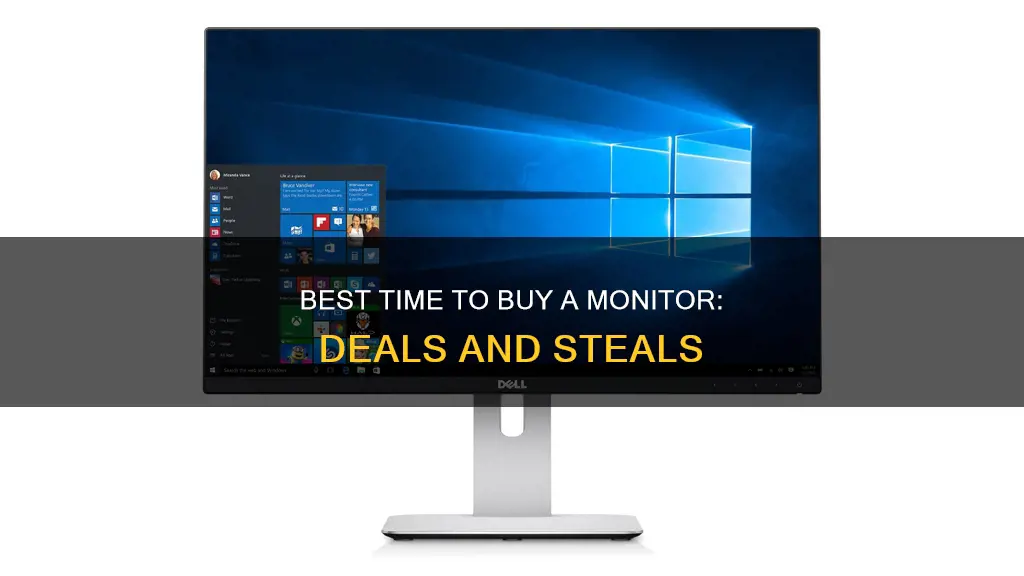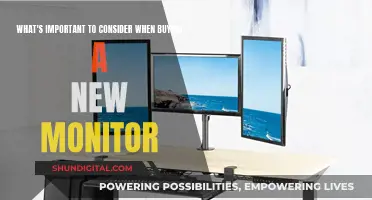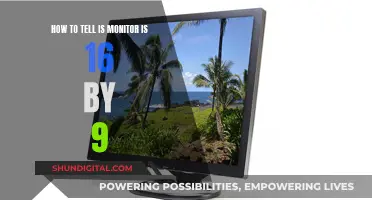
If you're looking to buy a monitor, there are a few times of the year that are ideal for shopping around. Black Friday is, unsurprisingly, the best time to snap up a bargain, with Cyber Monday following closely behind for online deals. If you miss out on those, the Christmas holidays, January and February are also good times to buy a monitor, as manufacturers restock and lower prices to get rid of old inventory. Amazon Prime Day in July is another opportunity to find a good deal, as well as the 'back to school' period from mid-July to mid-September. If you're not in a rush, it's worth waiting for one of these sales periods to roll around, but if you need a monitor ASAP, retailers like Best Buy and Amazon host spontaneous sales on select monitor models all year round.
| Characteristics | Values |
|---|---|
| Best time of year to buy a monitor | Black Friday, followed by Cyber Monday, Christmas holidays, January and February, 'back to school' period (mid-July to mid-September) and Amazon Prime Day (July 11-12) |
| Best places to buy a monitor | Best Buy, Amazon, Tom's Hardware, Dell, HP, Asus, ViewSonic, LG |
What You'll Learn

Black Friday and Cyber Monday
Black Friday, which falls on November 29, 2024, marks the official beginning of the holiday shopping season. However, early sales and discounts on monitors are already available from major retailers like Amazon, Best Buy, Newegg, Dell, and Walmart. These early deals can provide significant savings, allowing consumers to secure a display ahead of Black Friday itself.
When looking for Black Friday monitor deals, it's important to remember that retailers may try to clear their old stock. While these monitors may have outdated specs, they can still be perfectly usable. To ensure you get the best deal, look for monitors with at least 1080p resolution, preferably 1440p or 4K if your budget allows. Additionally, consider your specific needs, such as colour accuracy for photo and video editing or a high refresh rate and quick response time for gaming.
Some of the best early Black Friday monitor deals for 2024 include:
- Dell S2722DGM: $249 at Dell (originally $299)
- Samsung 49-inch Odyssey G9: $999 at Amazon (originally $1,599)
- Dell Curved Gaming 34-Inch Monitor: $345 at Amazon (originally $449)
- Acer Nitro 27-inch WQHD gaming monitor: $200 at Amazon (originally $289.99)
- LG UltraGear 27GL83A-B 27-inch QHD monitor: $199.99 at Amazon (originally $299.99)
Cyber Monday, falling on December 2, 2024, is the online counterpart to Black Friday. While Black Friday offers a mix of in-store and online deals, Cyber Monday primarily focuses on online sales. Both events offer competitive prices on monitors, with discounts available on a wide range of monitor models.
To make the most of these sales events, it's advisable to research and compare deals in advance, considering factors like panel technology, resolution, refresh rate, and connectivity options. Knowing exactly which monitor you want before Black Friday or Cyber Monday will enable you to act swiftly when prices drop.
Amazon Refurbished Monitors: Buy or Avoid?
You may want to see also

Christmas and January sales
If you're looking to buy a monitor during the Christmas and January sales, you're in luck! This period is one of the best times to find deals on monitors, especially with the post-Christmas sales and retailers looking to shift stock in the new year.
Many retailers will be offering discounts on monitors, so it's a great time to find a bargain. You can expect to see deals on monitors of all types, including gaming monitors, professional monitors, and general-use monitors. Here are some tips and things to look out for when buying a monitor during the Christmas and January sales:
- Know what type of monitor you want. Are you a gamer, a professional, or a general user? Each type of user has different priorities when it comes to monitors. For example, gamers should prioritize fast refresh rates and low response times, while professionals should focus on color accuracy.
- Look for deals at major retailers. Amazon, Newegg, Dell, and Best Buy are some of the retailers that typically offer great deals on monitors during this period. Keep an eye on their websites and promotional emails for the latest deals.
- Compare prices and specifications. During the sales period, you'll have a lot of options to choose from. Make sure to compare the prices and specifications of different monitors to find the best deal for your needs. Pay attention to factors such as resolution, refresh rate, response time, panel type, and additional features.
- Check for bundle deals. Sometimes, retailers will offer bundle deals where you can get a monitor and other accessories, such as cables, stands, or peripherals, at a discounted price. This can be a great way to save money and get everything you need for your setup.
- Don't forget about smaller retailers. While the big-name retailers will have plenty of deals, don't forget to check out smaller specialty stores or local shops. They may also be offering discounts, and you might find a hidden gem or a unique deal that suits your needs perfectly.
- Be flexible with your budget. The Christmas and January sales are a great time to find deals, but it's important to be flexible with your budget. You may find a monitor that slightly exceeds your budget but offers significantly better specifications or features. Consider the long-term value and how long you plan to use the monitor.
- Read reviews. When you're deciding between different monitors, be sure to read reviews from trusted sources and other customers. This can give you valuable insights into the performance, durability, and overall experience of using the monitor.
By following these tips and keeping an eye on the Christmas and January sales, you'll be well-positioned to find a great deal on a monitor that suits your needs and budget. So, get ready to upgrade your display and enjoy an enhanced viewing experience!
Tucson's Best Places to Sell Your Old Monitors
You may want to see also

'Back to school' period
The 'back to school' period is a great time to buy a monitor, as retailers will be anticipating shoppers buying for college and school. This period runs from mid-July to mid-September, so you have a good two-month window to find a bargain.
During this time, you can expect to find sales on mainstream brands such as Acer, ASUS, Dell, HP, Lenovo, LG, Samsung, and ViewSonic. Amazon Prime Day, which falls in July, is also a great time to buy a monitor, as many retailers will be offering deals to compete with Amazon.
If you're looking for a monitor for gaming, you'll want to prioritise fast refresh rates and low response times. A refresh rate of 75Hz is ideal, with a maximum response time of 5ms. For non-gamers, a 60Hz refresh rate will be sufficient.
When it comes to screen size, 32 inches is plenty big for viewing from a typical desktop distance. If you're after a larger monitor, keep in mind that the price will likely increase.
In terms of resolution, 1920 x 1080 (also known as 1080p, Full HD, or HD) is the minimum you'll need. You'll get sharper images with QHD (2560 x 1440) and even sharper with 4K (3840 x 2160).
If you're buying a monitor for photo or video editing, you'll want to consider a larger screen with at least Full HD or Quad HD resolution for more screen space and highly detailed images. An IPS panel is a good choice for its deep blacks, accurate colours, and wide viewing angles.
For the best deals during the 'back to school' period, keep an eye on retailers' websites and deal sites, and sign up for price-tracking tools like CamelCamelCamel. With a bit of research and flexibility, you're sure to find a great monitor at a bargain price.
Connecting Powered Monitor Speakers to an Amplifier: A Step-by-Step Guide
You may want to see also

Amazon Prime Day
Ultrawide Monitors
If you're after a super-immersive viewing experience, an ultrawide monitor is the way to go. And Prime Day delivered some impressive deals on these widescreen displays. The Samsung 49-inch Odyssey G9 saw a massive 38% discount, dropping the price to just $800. Or, if you're after something even bigger, the Samsung 57-inch Odyssey Neo G9 was discounted by 36%, bringing the price down to $1,600.
Display Monitors
For those seeking a more standard display, there were plenty of deals to be had on regular monitors, too. The Dell S2725DS 27-inch QHD Monitor was a great option for those wanting a mid-sized display, with a 36% discount bringing the price down to $140. And for those wanting something a little smaller, the Samsung 22-inch T350 was a steal at just $90 after a 25% discount.
Portable Monitors
If you're looking for something more compact and travel-friendly, Prime Day also offered deals on portable monitors. The Arzopa 15.6-inch Portable Monitor was a fantastic deal at just $60, a massive 54% discount. And for those wanting something a little bigger, the UPerfect 16-inch Portable Monitor was discounted by 40%, bringing the price down to $144.
Gaming Monitors
Of course, Amazon Prime Day also delivered on deals for gamers. The Samsung 55-inch Odyssey Ark (2nd Gen) Curved Gaming Monitor was a standout deal, with a huge 40% discount bringing the price down to $1,800. And for those wanting a curved display, the Dell S3422DWG 34-inch Curved Gaming Monitor was a great option, discounted by 30% to $280.
So, whether you were in the market for a new work monitor or a high-spec gaming display, Amazon Prime Day had something to offer. With discounts on top brands and a range of sizes and features, it was the perfect time to upgrade your setup.
Widescreen Monitor Sizes: Understanding the Standard Dimensions
You may want to see also

Compare new and old models
The monitor market is constantly evolving, with new features and improvements being introduced every year. If your monitor is more than five years old, it may be time to consider an upgrade. Here are some key differences between new and old monitor models to help you decide:
Resolution
Newer monitors offer higher resolutions such as Quad HD (QHD) and 4K Ultra HD, which provide sharper and more detailed images. Older monitors typically have lower resolutions like Full HD (1080p) or even lower, resulting in less crisp visuals.
Refresh Rate
Refresh rate refers to how many times per second your monitor updates with new information and is measured in hertz (Hz). Newer monitors have higher refresh rates, with gaming monitors offering at least 120 Hz and some going up to 240Hz or even 500Hz. Older monitors often had a standard refresh rate of 60 Hz, which can cause screen tearing and a less smooth viewing experience.
Response Time
Response time measures how long it takes for a monitor to change individual pixels from black to white or between shades of grey. Newer monitors have shorter response times, reducing motion blur and ghosting effects during fast-paced games or videos. While older monitors might have response times of 12 ms or more, newer ones can go as low as 0.5 ms.
Panel Technology
There are three main types of LCD panel technologies used in monitors: Twisted Nematic (TN), Vertical Alignment (VA), and In-Plane Switching (IPS). TN panels are typically found in older monitors and offer faster response times but poorer image quality when viewed from side angles. IPS panels, more common in newer monitors, have better colour accuracy and viewing angles than TN panels. VA panels provide the best contrast and image depth, making them ideal for professional users requiring accurate colour reproduction.
Additional Features
Newer monitors often include additional features such as curved screens, which provide a more immersive viewing experience and reduce eye strain. Adaptive sync technologies like Nvidia G-Sync and AMD FreeSync help reduce screen tearing and improve responsiveness during gaming. Built-in USB-C hubs offer expanded connectivity options, especially useful for laptops.
In summary, newer monitors offer significant improvements in terms of resolution, refresh rate, response time, panel technology, and additional features. These enhancements provide a better viewing experience, smoother gameplay, and improved colour accuracy. If your current monitor is several years old, upgrading to a newer model can bring noticeable benefits and improve your overall computing experience.
Best Monitors to Pair with a 1660 Ti Graphics Card
You may want to see also







